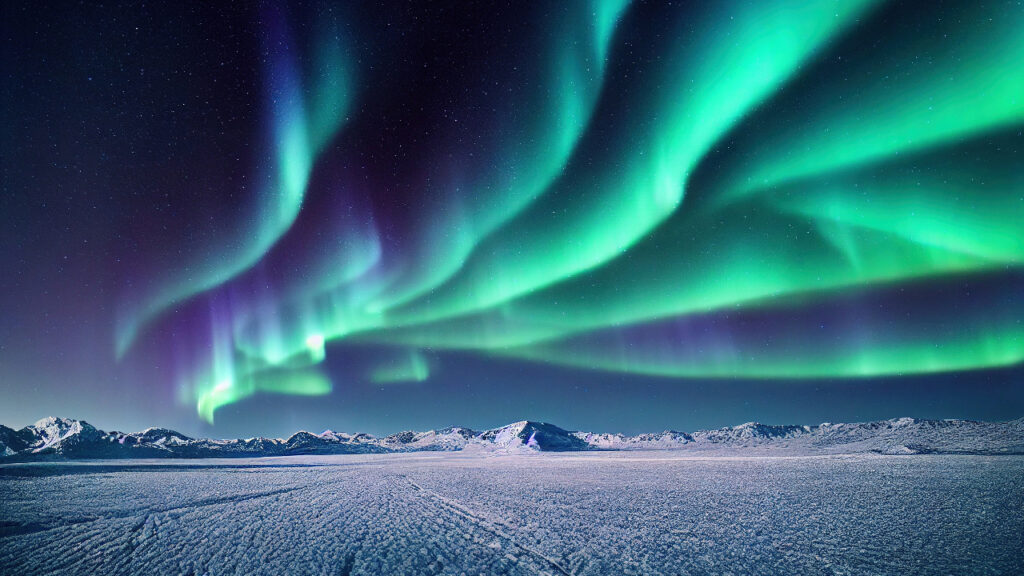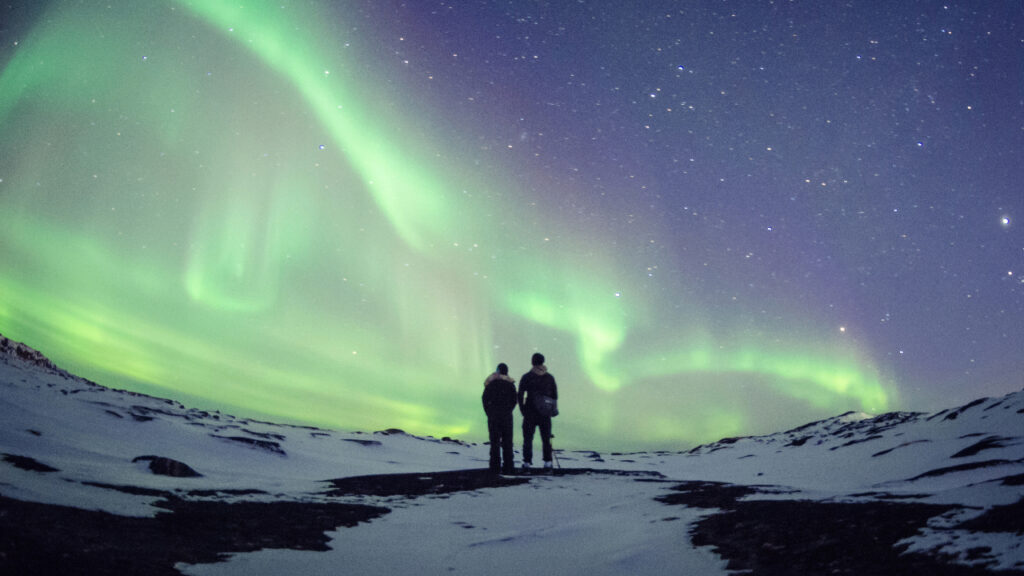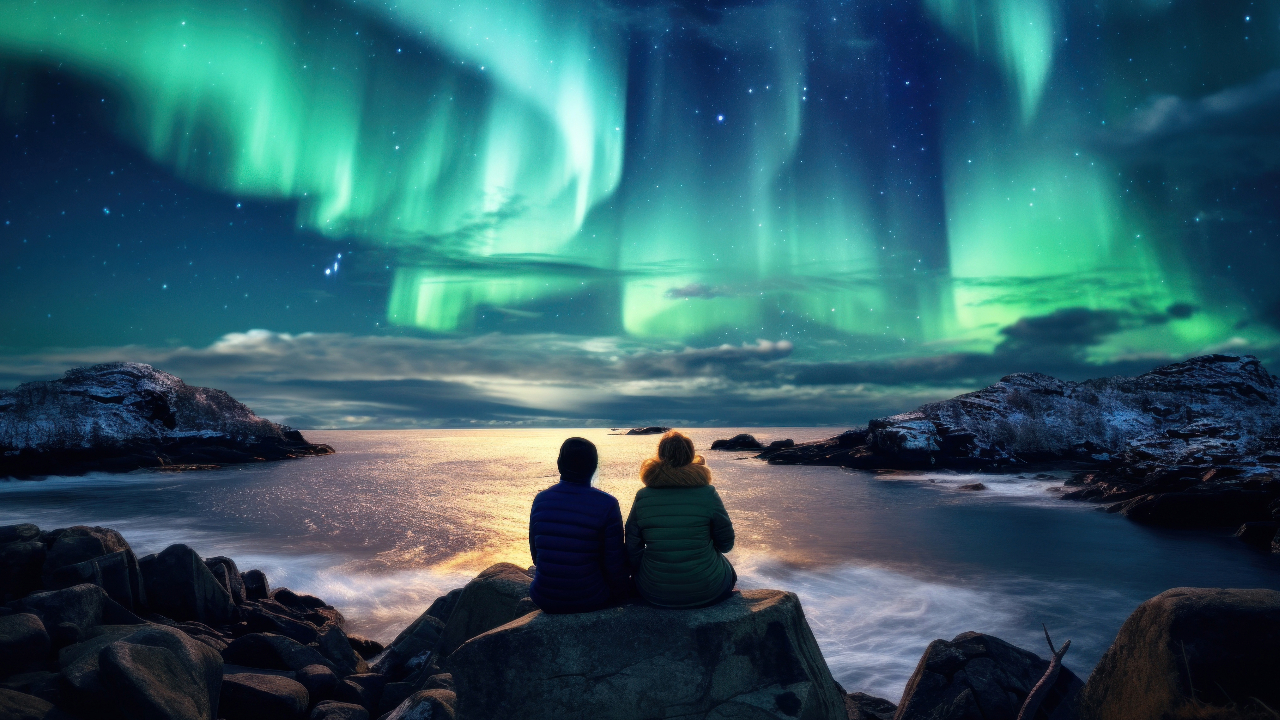As the northern skies bloom with the radiant dance of the Aurora Borealis, Scandinavia invites couples on a honeymoon unlike any other. Imagine standing hand in hand, under a canopy of ethereal lights that have journeyed from the sun to greet you on your new adventure together. This is not just a holiday; it’s an intimate ballet of celestial wonders, a natural symphony playing in honour of your union. The Northern Lights are not just a backdrop; they are a majestic participant in your love story, offering a once-in-a-lifetime experience that intertwines the romance of the cosmos with the bonds of the heart. Here, amidst the serene beauty of Scandinavia’s winter landscape, you will forge memories that are as indelible as the stars themselves.
▶️ Read also: The benefits of a small intimate wedding in Europe
Understanding the Aurora Borealis
Understanding the Aurora Borealis requires delving into the cosmic dance between the Earth and the Sun. This spectacular light show begins with the Sun ejecting a cloud of gas, a phenomenon known as a coronal mass ejection. If one of these reaches Earth, it collides with the magnetic field that protects our planet.
As the Earth’s magnetosphere gets bombarded by solar wind, it’s largely deflected, but the solar particles are funnelled towards the poles by the field lines. These particles then collide with gases in our atmosphere, such as nitrogen and oxygen. This collision imparts energy to the atmospheric gas molecules, which they later release as the mesmerizing colours of the aurora. Oxygen gives off green and red light, while nitrogen glows blue and purple.
The most common colour seen in the auroras is a bright green, produced by oxygen molecules located about 60 miles above the Earth. Red auroras are produced by high-altitude oxygen, at heights of up to 200 miles. Nitrogen produces blue or purplish-red aurora.
The auroral ovals are the regions where the lights are most often seen. These ovals centre on the geomagnetic poles, expanding and contracting based on the intensity of solar activity.
The KP index is a scale used to measure the geomagnetic activity and can predict the likelihood of the Northern Lights appearing. It ranges from 0 to 9, with higher values indicating greater activity and a higher chance of experiencing the aurora.
For more detailed scientific explanations, you would typically look towards authoritative sources such as NASA’s official website, the National Oceanic and Atmospheric Administration (NOAA), or dedicated aurora service websites like Aurora Service (Finland) which provide educational resources and real-time aurora forecasts.

Best time to witness the Northern Lights
The auroral displays are not a constant feature in the night sky, but are most prevalent during the equinoctial months, which are September and March. This is when geomagnetic storms are more likely due to the position of the Earth in relation to the Sun, enhancing solar wind interaction with the planet’s magnetic field. During these months, the nights in the Arctic Circle are sufficiently dark and long, providing an extended window and a darker canvas for the lights to be visible.
Furthermore, the best time of night to view the Northern Lights is typically between 9 PM and 2 AM local time. This is when geomagnetic activity, on average, peaks due to the “auroral oval,” the area with the most aurora activity, aligning better with the night side of the Earth.
However, this does not preclude sightings outside of these hours; the auroras can appear at any moment when conditions are right. Additionally, the phase of the moon and local weather conditions play a crucial role. A new moon phase is ideal, as the sky is darkest then, and clear, cloudless nights are essential for an unobstructed view of this natural phenomenon. It’s advisable to monitor space weather forecasts and plan for multiple nights of observation to increase the chances of a sighting.
▶️ Read also: Hidden costs in planning a destination wedding in Europe
Prime locations in Scandinavia (and Finland)
Scandinavia, with its northern latitude and vast wilderness, is dotted with prime locations that offer some of the world’s best views of the Northern Lights.
In Norway 🇳🇴
- Tromsø: A major urban area well above the Arctic Circle, offering excellent chances of aurora sightings.
- Lyngen Alps: For those seeking a dramatic setting, the high peaks provide a majestic backdrop for the lights.
- Lofoten Islands: Offers a more tranquil experience with a stunning coastal environment and traditional fishing villages.
In Sweden 🇸🇪
- Abisko National Park: Near Kiruna, it’s famous for its clear skies and the Aurora Sky Station, which is specifically designed for observing the Northern Lights.
- Kiruna: Aside from Abisko, Kiruna itself is an excellent base for aurora hunting, with numerous tours available.
In Finland 🇫🇮
- Rovaniemi: Lapland’s capital, it combines aurora viewing with unique local culture.
- Kakslauttanen Arctic Resort: Located in Finnish Lapland, it offers glass igloos for a comfortable aurora watching experience.
- Ivalo: A small village with minimal light pollution, providing clear dark skies for aurora observations.
- Saariselkä: A resort village in northern Finland, known for its proximity to good viewing spots and winter sports.
Each location offers a blend of natural setting and local amenities to enhance the Northern Lights experience.

Integrating the Northern Lights into your honeymoon adventure
Incorporating the Northern Lights into a honeymoon creates an enchanting and memorable experience. Couples can intertwine the natural splendor of the auroras with intimate activities to celebrate their union.
- Private aurora tours: book a private guided tour that caters specifically to couples, offering a romantic and personal aurora hunting adventure. These tours can take you to off-the-beaten-path locations for the most intimate viewing experiences. 🔗 Some websites ? Of course : TourRadar which offers a selection of over 123 private trips in the Nordic and Scandinavian region or 50 Degrees North, a specialist in Northern Lights tours with more than 50 unique options across Norway, Finland, Sweden, and Iceland.
- Overnight stays in glass igloos: spend a night in a glass igloo in places like Finland’s Kakslauttanen Arctic Resort, where you can gaze at the Northern Lights from the warmth and comfort of your bed.
- Aurora photography sessions: arrange for a professional photographer to capture your moments under the auroras. These photos will be a lifelong reminder of your honeymoon and the magical experiences shared.
- Aurora-inspired dinners: enjoy a candlelit dinner in a remote location with a menu inspired by local delicacies, all while waiting for the lights to appear. Some resorts offer this as part of an aurora experience package.
- Aurora cruises: in coastal areas, especially in Norway, couples can embark on a nighttime cruise where they can witness the Northern Lights reflecting over the ocean. Some website ? Yes : Viking Cruises, which provides an itinerary specifically “In Search of the Northern Lights”, or Cunard offers a 12-day Northern Europe cruise aboard the Queen Anne, featuring evening departures and an opportunity to spot the Northern Lights.
- Cultural activities: engage in local cultural activities during the day. From Sami experiences in Lapland to Viking history tours in Norway, these activities can add a rich cultural dimension to your honeymoon.
- Relaxing in nature: choose a secluded lodge where you can enjoy daytime hikes or simply relax by a fire, creating moments of connection before the night’s aurora show begins.
In the embrace of Scandinavia’s twilight, the Northern Lights offer a symphony of colors that make a honeymoon not just a journey, but a foray into the realm of wonder. As the auroras swirl above, they remind us of the enduring dance of the cosmos, a fitting tribute to the celebration of love and union. This natural marvel doesn’t just paint the sky; it weaves into the tapestry of memories that couples will cherish forever. Whether it’s through a quiet moment shared under the emerald glow or an adventure in the crisp Arctic air, a honeymoon here promises the magic of the aurora as a companion in the beginning of your shared story.






